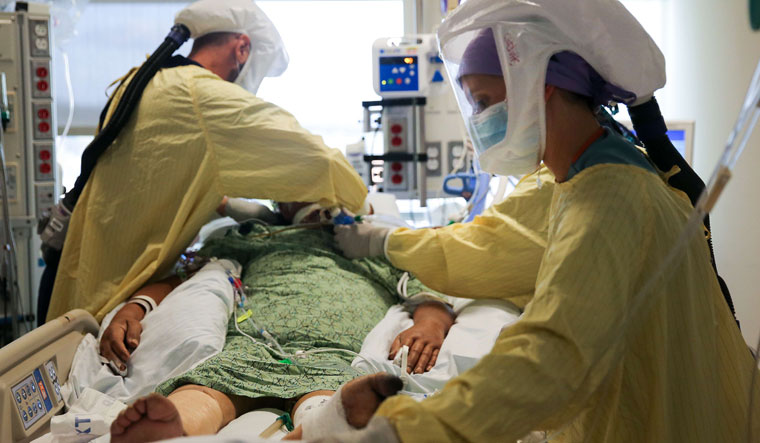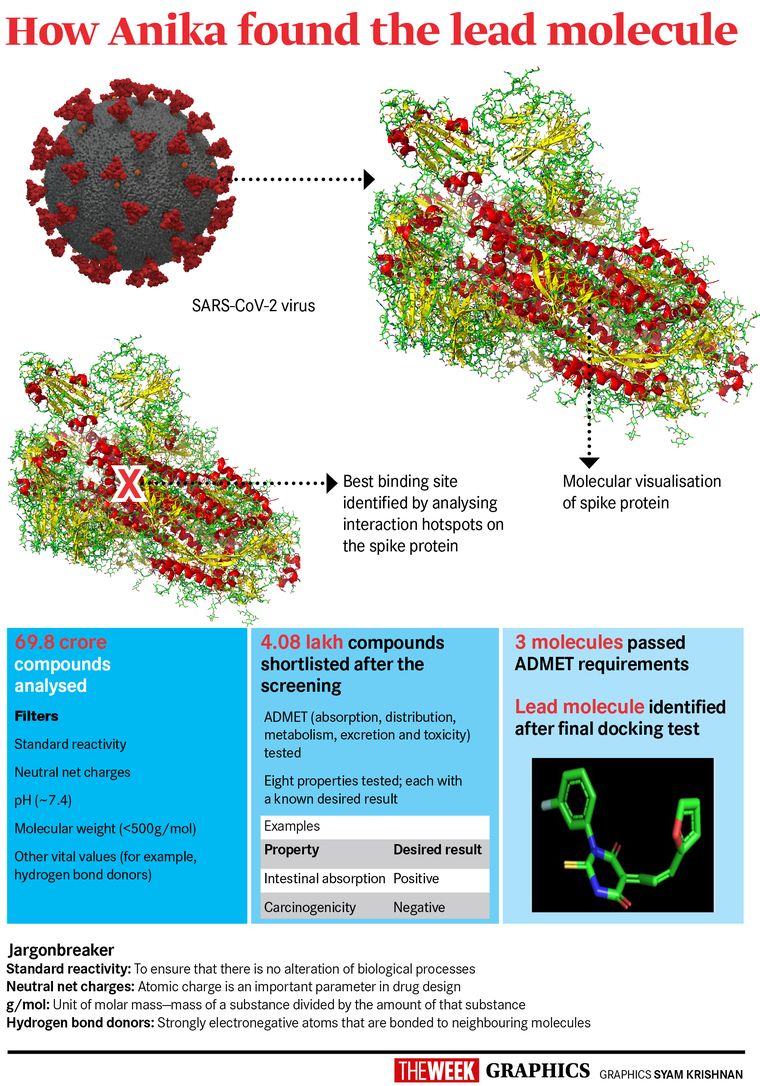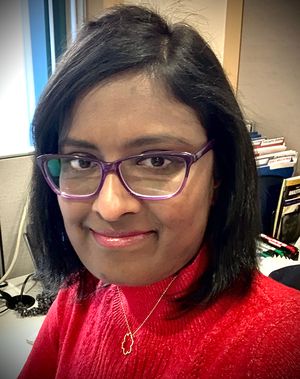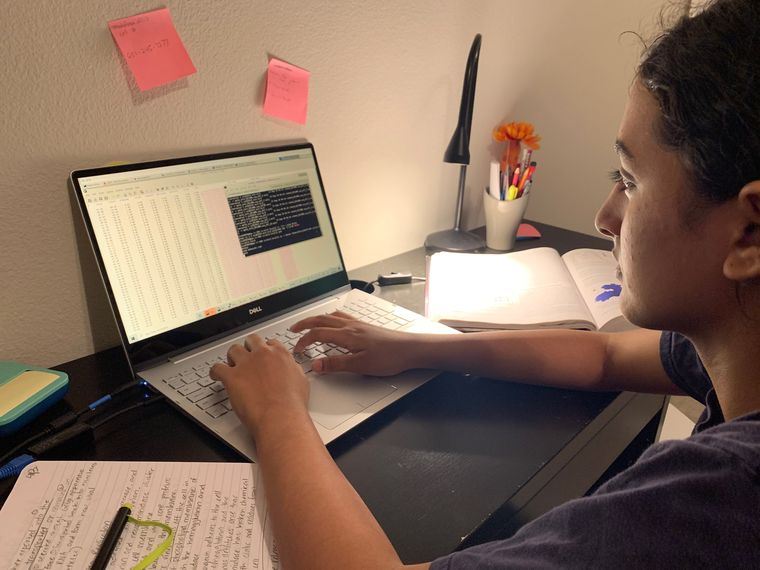While the Covid-19 pandemic rages globally and vaccines are being rolled out to halt its spread, a US-based teenager has discovered a potential solution to the deadly disease. Fourteen-year-old Anika Chebrolu from Frisco, Texas, has identified a molecule that can fuel a prospective antiviral against Covid-19 infection. Anika, who won the 2020 3M Young Scientist Challenge, is modest about her achievement yet excited about what it means for humanity. “I think my discovery is a drop in the ocean,” she tells THE WEEK. “If it can supplement other breakthroughs to fight against Covid-19, that would be a reward in itself.”
The lead molecule that Anika identified can selectively bind to the spike protein of the SARS-CoV-2 virus and change its shape. This will prevent the virus from being able to grab on to other human cells, stopping further penetration and infection in a person’s body. “Basically, if you can stop the spike protein from functioning properly with use of this molecule, you can potentially stop the SARS-CoV-2 virus from spreading within the body,” she says.
Anika’s discovery offers global hope for a potential cure. Her mentor Dr Mahfuza Ali, corporate scientist with 3M Company headquartered in Minnesota, explains the effect for the world thus: “Essentially, she is closing the door of the coronavirus from the get-go so that it cannot latch on to the human cell, cannot multiply and thus cannot transfer from human to human.”
With the global death count from Covid-19 at 16.23 lakh and rising, and America’s own grim milestone of 3 lakh plus deaths, the medical community has welcomed Anika’s breakthrough. Dr Grant Wang, a primary care physician in Berkeley, California, has been working on the frontlines treating Covid-19 patients since the outbreak spread in the US in early 2020. Like his global counterparts, he, too, has been concerned by the high number of Covid-19 cases and deaths worldwide, and especially in America, and agrees that “there is a dire and urgent need for vaccines and drugs that can inhibit the coronavirus”. Current treatments are limited to steroids like prednisone, antivirals like remdesivir, and Regeneron’s antibody cocktail that received Food and Drug Administration (FDA) emergency approval after it was used on President Donald Trump.
While an actual antiviral drug fuelled by Anika’s findings will take some time, Wang is heartened by Anika’s breakthrough. “Even with the onset of vaccinations, Anika’s discovery is pertinent and significant because of its potential for inhibiting replication or function of the virus. It seems like a promising way forward, and when it does come to fruition it will give doctors one more option for Covid-19 treatment,” says Wang.
Anika herself was excited and relieved by news of the successful formulation of Covid-19 vaccines. “I think a vaccine with above 90 per cent efficacy at this point against such a deadly virus is simply great,” she says. Does she give the naysayers who question the vaccine, and some even the science itself, the teen eyeroll? She laughs, and offers this sober statement: “To those who don’t believe in the vaccine, I would say let’s take a lesson from history and the death toll of the Spanish flu of 1918. Today, we have annual flu shots to remedy that situation. We should use the Covid-19 vaccines the same way to stem the loss of life as we work to develop other antiviral treatments. Science is the basis of life.”
Anika credits her love for science as the reason for her success. It took the young scientist more than three years of dogged research to make the pivotal breakthrough. But it was a Grade 6 science project in fall 2017 that piqued her interest in viruses and set her on the path. In Grade 7 the following year, Anika built upon her curiosity and began to feverishly read and research the Spanish flu and other viruses. By 2019 and in Grade 8 at Nelson Middle School, the Chebrolus’ middle child was a full-on independent researcher in her own right, scouring databases and using the in-silico method to find a novel anti-influenza drug. When 3M Company announced its Young Scientist Challenge, it was her elder brother, Aditya, who hustled with Anika to send in her research project as an entry in December 2019. Titled ‘Combating the Influenza Epidemic: In Silico Molecular Docking of Hemagglutinin Protein to Develop a Novel Anti-Influenza Drug’, it was not just a mouthful, but a handful as well.
Still, it wasn’t just the ambitious nature of her project, but her use of ‘in silico’ methodology that caught the eye of Ali at 3M Company, the American conglomerate with a global presence in varied fields and predominantly in the US health care sector. In June 2020, 3M announced that Anika was selected to be in the top 10, and Ali stepped in as her mentor. Anika looked set to plumb the depths of science and technology in her bid to find a novel influenza cure. Then Covid-19 gripped the world, and online discussions between Anika and Ali resulted in a decision that would create history, and perhaps even change its course with reference to the pandemic.
Anika, in consultation with Ali, decided to pivot from researching influenza and target her research at SARS-CoV-2, given its catastrophic impact. Anika is grounded by the seriousness of the global situation. “It feels surreal after spending years reading and researching about viruses, pandemics and drug discovery, to be actually living through one,” she says. She renamed her project ‘In-Silico Molecular Docking of Spike Protein of SARS-CoV-2 Virus to Develop a Novel Antiviral Drug’.
Quiz Anika about Ali’s role in her success, and she is quick to respond: “She helped me gain access to technology, experts and research, which helped save time and scale up my research. Besides this, she helped immensely with organisation of the scientific research and streamlining of the research process itself.” Soft-spoken yet determined, and armed with Ali’s guidance, Anika spent time after school and weekends conducting her research. Ali recalls: “Over the summer, Anika and I met virtually, frequently, and discussed her progress at identifying the lead molecule that can selectively bind to the spike protein of the SARS-CoV-2 virus to find a potential treatment for Covid-19. In her research, Anika screened millions of small molecules and worked extremely hard to analyse these compounds in such a brief time.” In late October, Anika, now a freshman at Independence High School, Frisco, struck gold, identifying “the one” molecule that could outwit Covid-19. She went on to win 3M Young Scientist Challenge in October 2020.
Whom did she inform first when she found out she had made the breakthrough? No one right away, she recalls. She took time to double-check the results. Anika, who often references her family’s motto to “persevere at challenges” and never use the word “no”, then shared the good news with her mother, Poornima. The advice stood the ambitious scientist in good stead because searching for the one potential lead molecule in a pool of 69.8 crore had its fair share of frustrations. She recalls the one time around June or July when she input data for about 4 lakh molecules and received a recurrent “fatal error” message. Her family's motto helped her stay on course and revisit different pieces of the input data. “It was just two little data points and a molecule error that cost me three weeks of time and sleepless nights, but it was worth it in the end,” she says.
The Chebrolu family has maintained a low profile despite Anika’s recent fame. From interviews on major news networks in the US to discussions with science panels, they have let Anika, and her work, do the talking. Confident yet calm, she navigates the media interactions, expertly providing the audience a crash course in what ‘in-silico’ methodology entails. The method draws its name from the computer component silicium and thus, ‘in-silico’ methods refer to the use of computational methodologies. Known for their ability to formulate fast predictions for large sets of compounds, simulations can be conducted based on the structure of a compound before it has even been generated. Given this, ‘in silico’ studies are a crucial first step often used when pharmaceuticals or scientists intend to design new drugs or medical equipment like pacemakers.
Research has shown that the average SARS-CoV-2 particle has approximately 90 S-shaped spike trimers. Could she successfully isolate and find “the one” compound capable of disabling the S-shaped spike protein? That she screened not one or two, or a few hundred, but 69.8 crore molecules to make her breakthrough discovery and give the world a head start in creating an antiviral that could possibly cure Covid-19 impressed the scientific community worldwide. From a public health perspective, the importance of Anika’s research is not lost on the world at large, especially the medical community.
When epidemiologist Dr Jayapriyaa Shanmugham was pursuing her doctorate in public health at Harvard University, she did not imagine she would witness a pandemic in her lifetime. Nor could she have imagined the historic breakthrough and hope for a cure a teenager’s scientific acumen would provide during it. Currently the director of research in paediatric dentistry, Boston University, she responded to THE WEEK query about what impact Anika’s breakthrough means in the global scenario where Covid-19 vaccinations are underway. Cautiously optimistic, she has followed the promising results in the clinical trials reported by major pharmaceuticals, but reminds us that there are many unanswered questions about the efficacy across age and race markers, long-term side effects and duration of immunity, to name a few. “Therefore, given such unknowns, a finding like the one made by Anika Chebrolu is very significant and may even be the answer to some of these questions once her findings are tested in experimental clinical trials,” she says. “As researchers continue to learn about the virus, Anika’s finding contributes significantly to the scientific knowledge.”
Shanmugham’s words echo the reason why Anika chose not to patent her discovery. When THE WEEK pressed her about her decision not to file for a patent, Anika spoke with tremendous gravitas. “This pandemic is a new and challenging situation. Everyone’s role and work is important. A patent would lock up my scientific knowledge, whereas I wish for my discovery to play a role in bettering the situation for all humanity,” she says. Ali, too, maintains she remains very impressed with Anika’s maturity, poise and knowledge of drug discovery by in-silico methodology. For Anika, however, now is not the time to rest on her laurels. Smiling determinedly, she tells us she is “far from done with the SARS-CoV-2 virus”.
The high school scientist hopes to work with researchers “to conduct in-vitro and in-vivo testing of her lead drug candidate so as to secure an actual cure for the virus”. How she develops this molecule with the help of virologists and pharmaceutical scientists will determine the success of her find. But she is up for the challenge and gets her indefatigable spirit from “her immensely supportive family”—mother Poornima, a software engineer, father Srivasa, a nephrologist, and brother Aditya, whom she terms her “role model”. Her parents are originally from Hyderabad, and moved to the US more than 20 years ago. Outside of family, her role model is scientist Marie Curie, who gets top marks for her science and sheer gumption at making it big in a male-dominated world of the yesteryears.
As this year’s winner of the 3M Challenge, Anika received a $25,000 (around Rs18.5 lakh) cash prize besides the title of America’s Top Young Scientist. She plans to use it to further her research and part-fund her nonprofit Academy Aid, which she cofounded with Aditya in India. It strives to help underrepresented students receive a well-rounded education by encouraging STEM (science, technology, engineering and mathematics) and providing supplies to underserved schools in India. Anika laughs when we ask if she will ever fit the normal teen stereotype with her penchant for philanthropy and history-making scientific research. “I was blessed with a supportive family that enabled me to pursue science and STEM,” she says. “With the Academy, I hope to empower other children by providing motivation and support. In a way, I want to help them find not just supplies but also their spirit to explore and discover things.” She tells us a story about a family trip to India and a drive through Secunderabad, to visit her mother’s alma mater. En route, they decided to stop at another school where the siblings learned girl students were playing truant because they did not have the required uniforms. Shortly thereafter, the duo founded Academy Aid and have since donated sports equipment, uniforms and other school supplies to several schools in the area.
Anika recognises the value of encouraging and engaging a child’s mind. She reveals her own love for science took seed in the many experiments referenced by her grandfather, Chebrolu Papa Rao, who was professor of chemistry at Osmania University. He encouraged her to “learn the periodic table of elements” not just for academic knowledge. Today, she is a celebrated young scientist who aspires to be a medical researcher in the future. Her not-so-secret mantra? “Never stop asking questions, and when you see an opportunity, just go for it,” she says. According to Poornima, Anika was always inquisitive and asked questions and tried to understand things beyond her age. “She was never afraid to speak her mind and always was truthful even if it meant trouble,” she says. “She was also quite creative and showed a lot of interest in art as well as dance. I believe her interest in art also stemmed from her grandfather's simple drawings that he did with her during her childhood.”
Dance is how Anika de-stresses. After all, trying to find an answer to the pandemic is heavy-duty stuff. She has been training in bharatnatyam formally for the last eight years. “I use my dance as a process to unwind,” she says, adding with amusement the fair amount of coaxing her parents required to give her permission to do so.
That said, she insists she is a normal teen who can entertain herself with her average guitar skills. She also unwinds by chatting with friends and having lunch with them over FaceTime and loves that they do not fuss much about her newly acquired fame. But she can simply lose herself in a book to unwind. A voracious reader, she loved her last read—The Hunger Games—and is raring to read The Lord of the Rings. But being in the business of research to rid the world of viruses has meant she has little time of late to indulge in a good read.
To Anika however, every sacrifice has been worth it. Her achievement has brought accolades from all over the world and within the Texan community. Even politicians have given her a shoutout. Congressman Van Taylor from Texas toasted her on social media and commended her for “aiming to better the lives of those around her”. Beth Meyer, vice president of growth and partner activation at Discovery Education that partnered with 3M for the Young Scientist Challenge, says that young scientists like Anika are the next generation of problem-solvers. “We are so proud of Anika for her research around treatment options for Covid-19 and are inspired by her ability to think creatively and apply the power of STEM to make the world a better place,” she says.
Shanmugham echoes the sentiments of the public and the research fraternity who have been astounded by Anika achieving so much at such a young age. “As a fellow researcher with a decade of experience, I am truly amazed that a 14-year-old achieved such a breakthrough and exhibited critical thinking and a high level of commitment to protect the health of the community,” she says. “One can only imagine the dedication and hard work she put in to provide new knowledge on the fight against coronavirus, a potential life-saver for humanity. And as an Indian American I feel very proud as well.”
It came as little surprise then, that Anika was also selected as a recipient of the 3M Competition’s ‘Improving Lives Award’ through a public voting process that recognised one project with the potential to change the most lives. For Anika though, it has simply been all in a day’s work.








